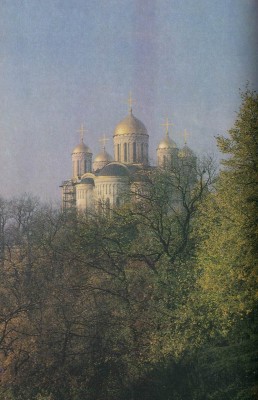South Russian Chronicle-Writing of the Twelfth Century
The Tale of Bygone Years carried the account up to the first decade of the twelfth century. Throughout this century chronicle-writing continued in various Russian principalities. These chronicles have not survived, however, and we know about them only from later chronicles in which they were wholly or partially included.
We can learn of South Russian chronicle-writing, for example, from the so-called Kievan Chronicle. This is the conventional name given by specialists to those entries in The Hypatian Chronicle which record events from the year 1117 to the end of the twelfth century62.
This part of the chronicle, which is assumed to have been redacted at the end of the twelfth century by Abbot Moses of the Vydubitsky Monastery (near Kiev), is a compilation that made use of the chronicles of the Kievan grand princes, The Chronicle of Pereyaslavl-Russky, and the family chronicle of the Rostislaviches, the descendants of Prince Rostislav, grandson of Vladimir Monomachos.63
Whereas the chroniclers of the eleventh century sought to view the events of their age against the background of the earlier history of Old Russia, the South Russian chroniclers of the twelfth century concentrated solely on describing the turbulent life of their principalities and appanages. In The Kievan Chronicle we find not tales and epic legends, but annual records, sometimes brief, sometimes very detailed, but nevertheless lacking the compositional unity without which the chronicle tale is inconceivable.
The Kievan Chronicle, particularly the entries for the 1140s, shows the chroniclers’ predilection for external, stylistic devices characteristic of the monumental historical style. Here one constantly finds traditional descriptions of battles, stereotype accounts of princes’ burials and obituaries.64
The Chronicle-Writing of Vladimir-SuzdalianRussia in the Twelfth Century. From the middle of the twelfth century the role of the Vladimir-Suzdalian principality grew increasingly important for Russia as a whole. The growing military and political importance of this principality, until recently one of the “borderlands”, was bound to lead to increased ideological activity as well. The brief records, which, we assume, were kept from the beginning of the twelfth century in Rostov and Vladimir, were replaced by chronicles.
These chronicles have not survived, but are reflected in later chronicles. Comparison of the latter has made it possible to establish that The Vladimir Chronicle of the late twelfth century was preserved in The Laurentian Chronicle, and a compilation of the early thirteenth century in the Radziwill and Moscow-Academic chronicles, and also in The Chronicle of Pereyaslavl-Suzdalsky.65
Vladimir chronicle-writing sought to establish the authority of the principality and substantiate its claims to political and ecclesiastical hegemony in Old Russia. For this reason the Vladimir chronicle-writers did not limit themselves to describing local events, but presented a broad picture of the history of the whole Russian land. South Russian events were recounted mainly according to the chronicles of Pereyaslavl-Russky [1] with which the princes of Vladimir had strong political ties.
The Radziwill Chronicle, which dates back to The Vladimir Chronicle of the early thirteenth century, contains more than 600 miniatures illustrating The Tale of Bygone Years and The Vladimir Chronicle of the twelfth century.66 It is possible that the thirteenth-century chronicle was also illustrated and that the miniatures in The Radziwill Chronicle are copies of its miniatures.
 History of Russian Literature
History of Russian Literature

